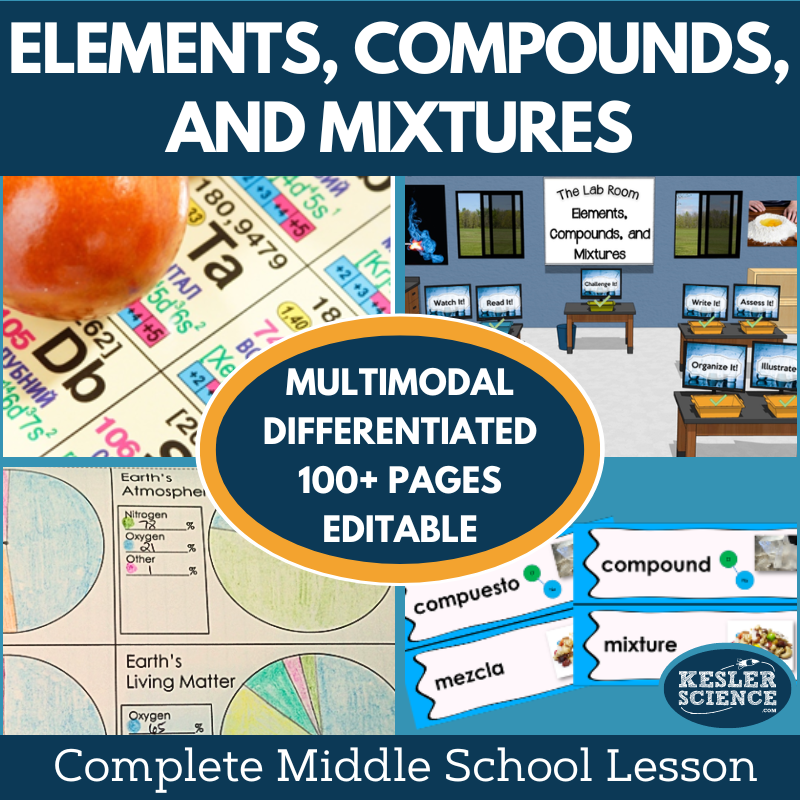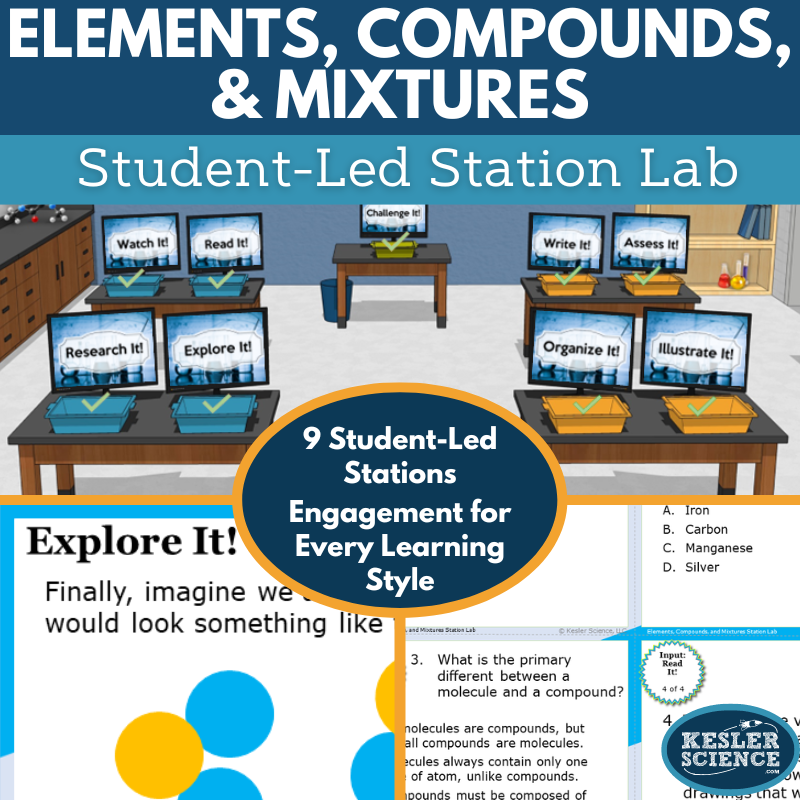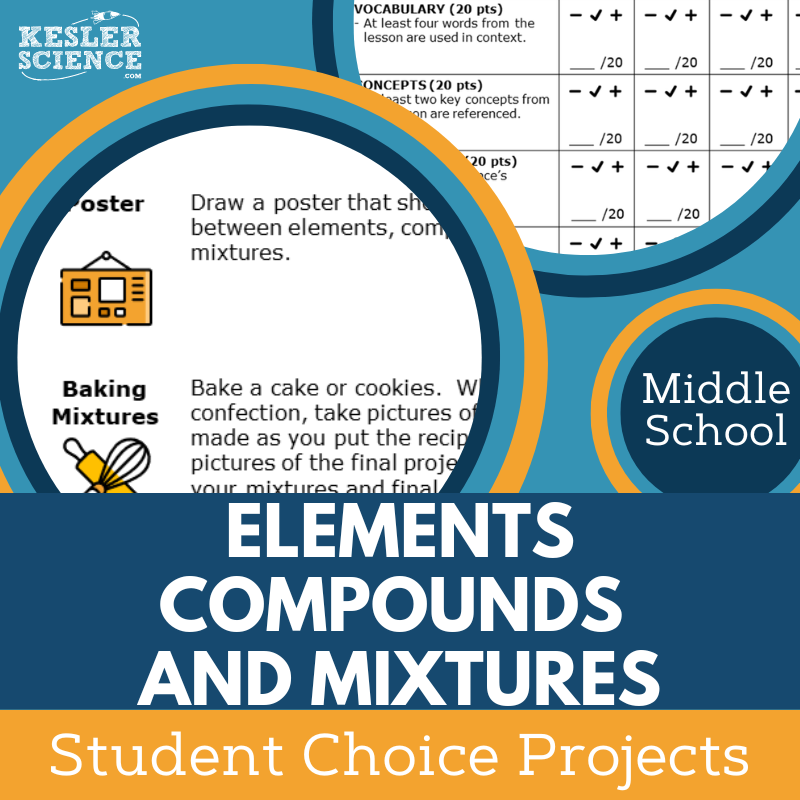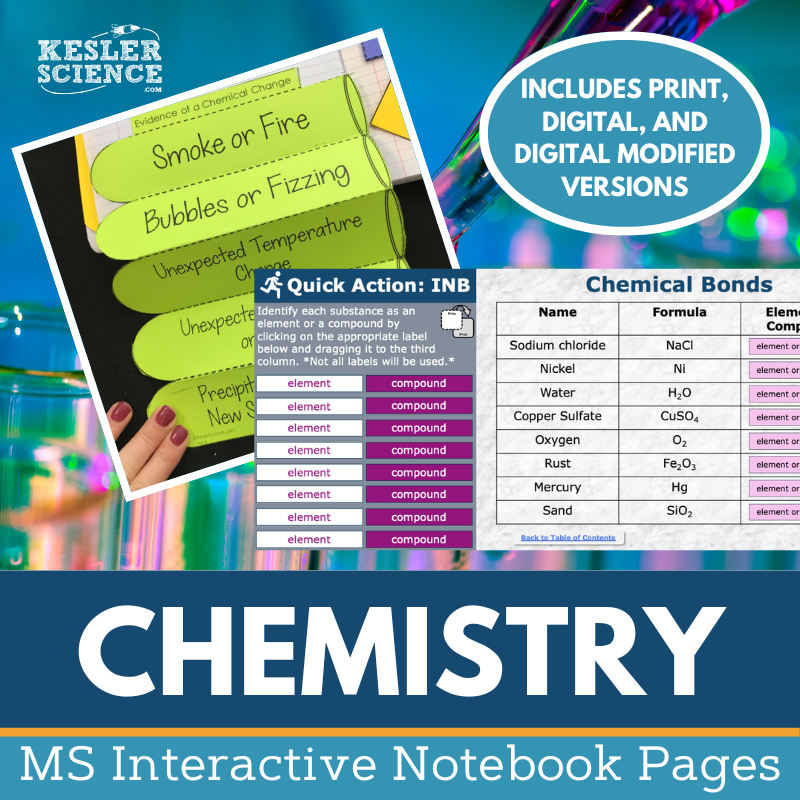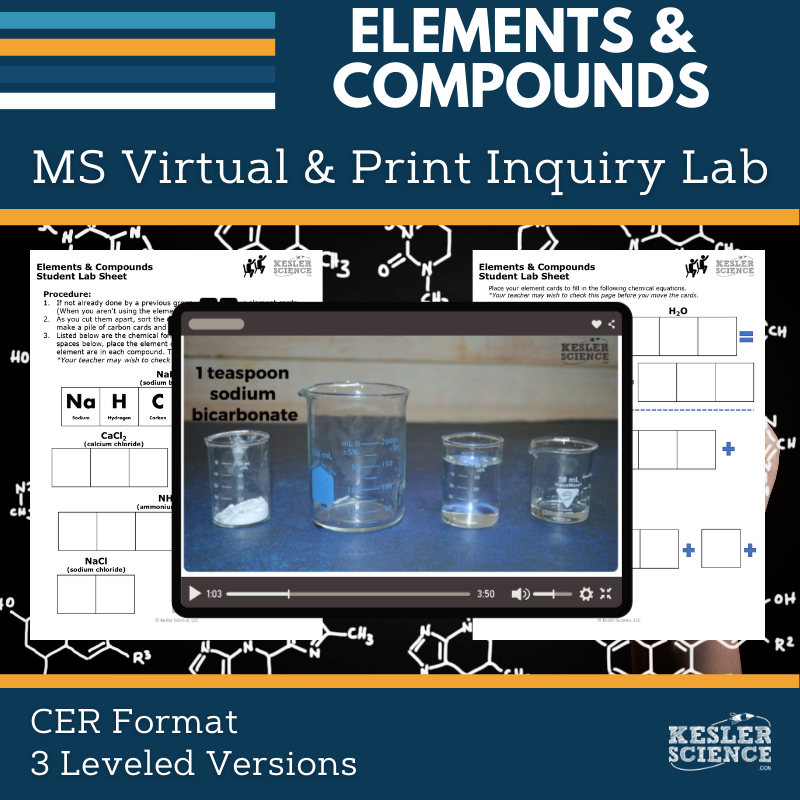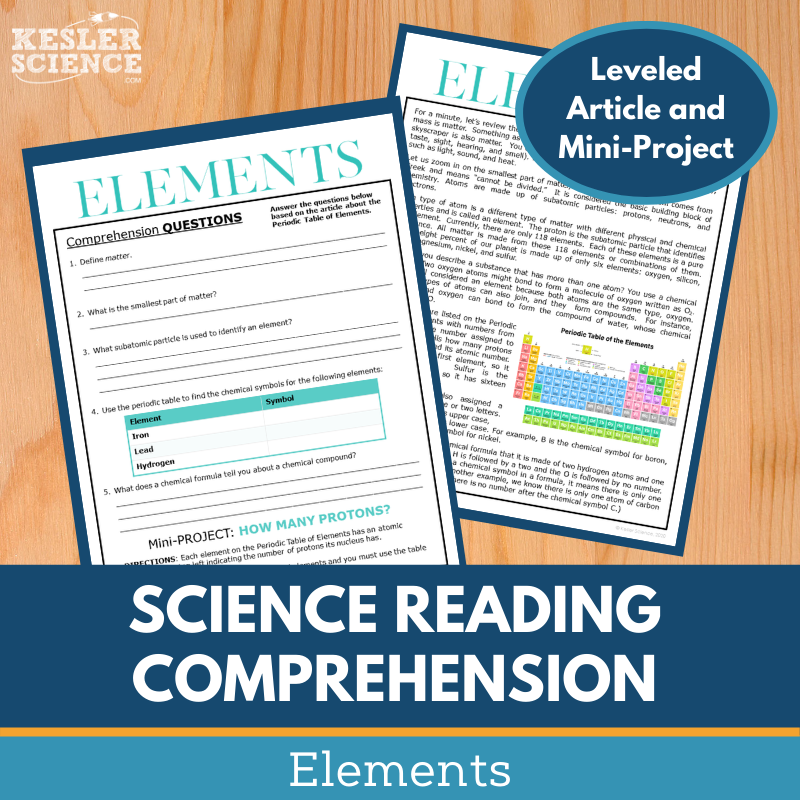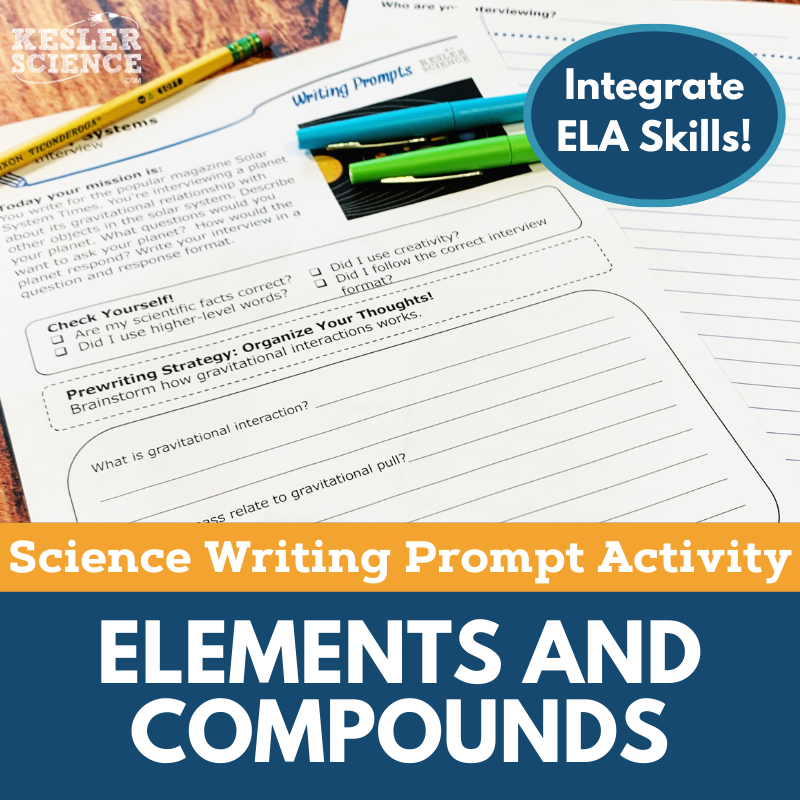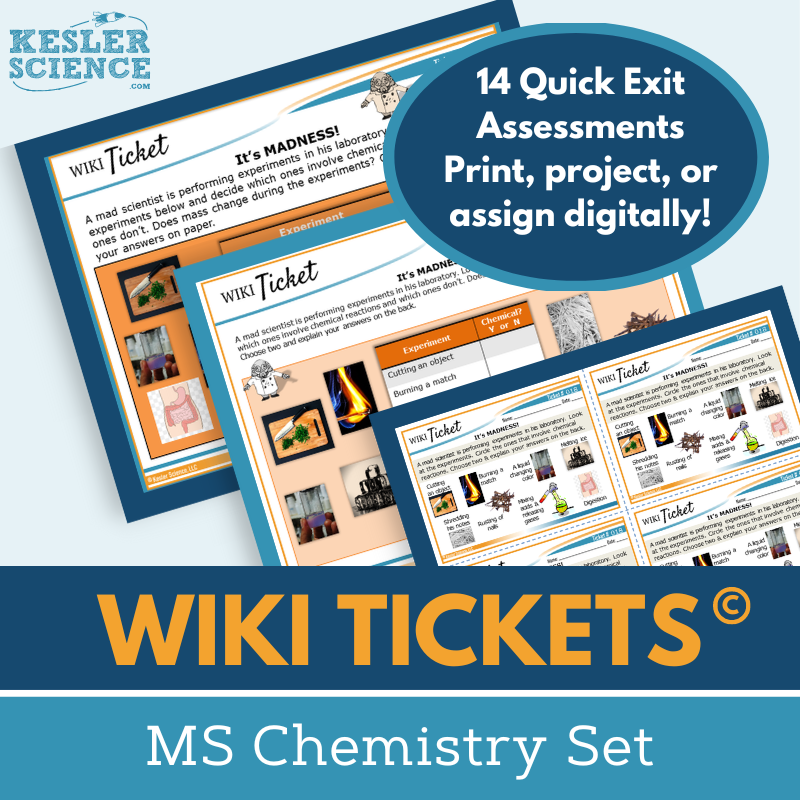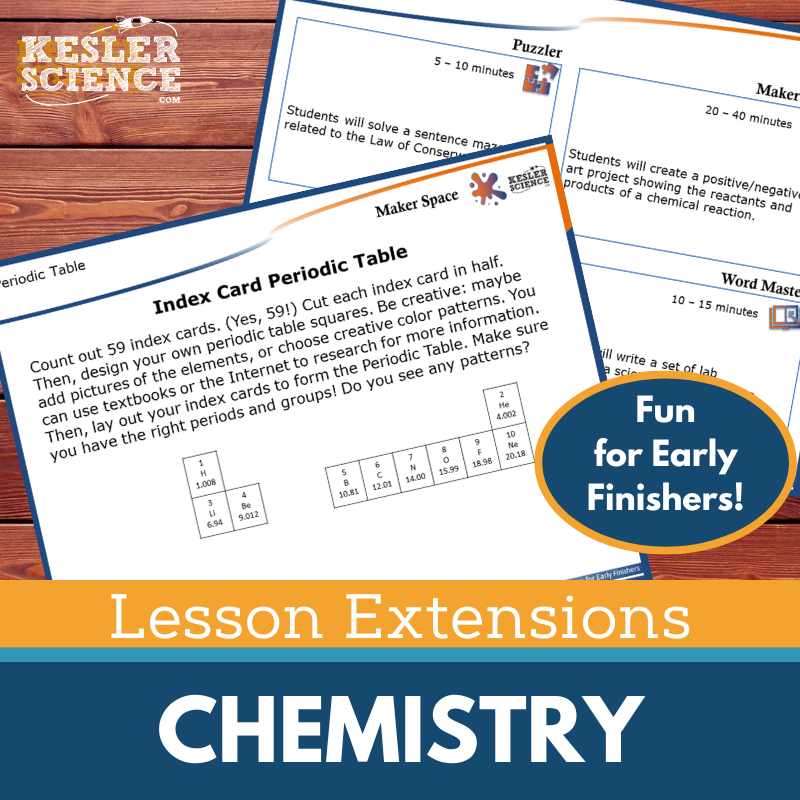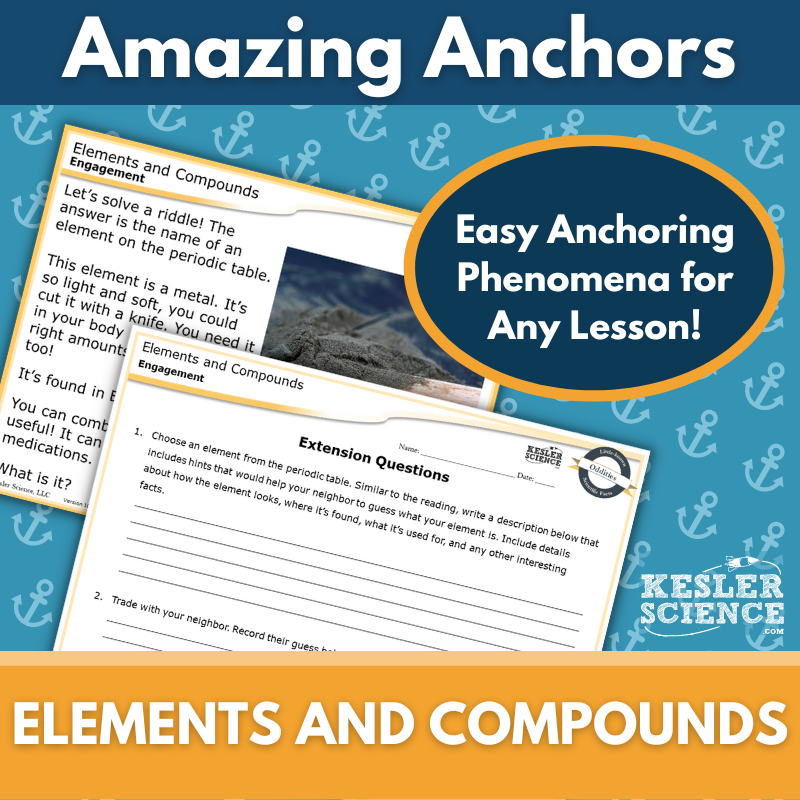Elements and Compounds of Earth Activities for Middle School Science
The Kesler Science Elements, Compounds, and Mixtures resources offer a comprehensive, engaging approach to teaching middle school students about the building blocks of matter. The resources below will give students a comprehensive understanding of elements, compounds, and mixtures. All of the following materials are also included in the Kesler Science Membership.
The Kesler Science Elements, Compounds, and Mixtures Complete 5E Lesson is a comprehensive, multi-day lesson that provides middle school students with a student-led, engaging approach to learning about elements, compounds, and mixtures. Built around the 5E Model, the lesson includes activities for Engagement, Exploration, Explanation, Elaboration, and Evaluation, making it easy for teachers to guide students through key scientific concepts with minimal prep. Differentiated materials cater to varying learning needs, and the lesson is available in both digital and printable formats, ensuring maximum flexibility.
In the Exploration phase, students engage in nine modular stations that introduce and reinforce concepts. These stations include a mix of input activities like hands-on experiments, research tasks, reading passages, and videos, as well as output activities such as writing prompts, illustrations, and assessments to demonstrate mastery. Bonus stations for early finishers provide additional opportunities for learning through fun extension activities.
The lesson also includes editable PowerPoints, interactive notebook templates, and student-choice projects to extend learning. Whether used in-class or virtually, this lesson ensures students are actively involved in their learning while allowing teachers to focus on student success.
The Kesler Science Elements, Compounds, and Mixtures Complete 5E Lesson is a comprehensive, multi-day lesson that provides middle school students with a student-led, engaging approach to learning about elements, compounds, and mixtures. Built around the 5E Model, the lesson includes activities for Engagement, Exploration, Explanation, Elaboration, and Evaluation, making it easy for teachers to guide students through key scientific concepts with minimal prep. Differentiated materials cater to varying learning needs, and the lesson is available in both digital and printable formats, ensuring maximum flexibility.
In the Exploration phase, students engage in nine modular stations that introduce and reinforce concepts. These stations include a mix of input activities like hands-on experiments, research tasks, reading passages, and videos, as well as output activities such as writing prompts, illustrations, and assessments to demonstrate mastery. Bonus stations for early finishers provide additional opportunities for learning through fun extension activities.
The lesson also includes editable PowerPoints, interactive notebook templates, and student-choice projects to extend learning. Whether used in-class or virtually, this lesson ensures students are actively involved in their learning while allowing teachers to focus on student success.
The Kesler Science Elements, Compounds, and Mixtures Station Lab is a modular, student-led activity designed to engage middle school students while teaching them about the building blocks of Earth. With eight differentiated stations, plus a bonus challenge station for early finishers, the lab allows students to take charge of their learning in a hands-on, student-centered environment. The teacher’s role is to facilitate rather than direct, giving students more ownership of their educational experience.
The stations include a variety of input activities, such as hands-on demonstrations, research tasks, reading passages, and videos that introduce students to the concepts of elements, compounds, and mixtures. For output, students can organize, illustrate, write, and assess their understanding through manipulatives, drawings, written responses, and task cards, providing multiple ways for them to express their knowledge.
This station lab is versatile, allowing for use in both physical classrooms and virtual learning environments. It is fully equipped with signage, task cards, literature, and resources needed to complete each station, saving teachers time on prep while ensuring an engaging, differentiated learning experience for students.
The Kesler Science Elements, Compounds, and Mixtures Station Lab is a modular, student-led activity designed to engage middle school students while teaching them about the building blocks of Earth. With eight differentiated stations, plus a bonus challenge station for early finishers, the lab allows students to take charge of their learning in a hands-on, student-centered environment. The teacher’s role is to facilitate rather than direct, giving students more ownership of their educational experience.
The stations include a variety of input activities, such as hands-on demonstrations, research tasks, reading passages, and videos that introduce students to the concepts of elements, compounds, and mixtures. For output, students can organize, illustrate, write, and assess their understanding through manipulatives, drawings, written responses, and task cards, providing multiple ways for them to express their knowledge.
This station lab is versatile, allowing for use in both physical classrooms and virtual learning environments. It is fully equipped with signage, task cards, literature, and resources needed to complete each station, saving teachers time on prep while ensuring an engaging, differentiated learning experience for students.
The Kesler Science Elements, Compounds, and Mixtures Student Choice Projects offer middle school students a variety of project options to match their learning styles. With six pre-designed project choices and a “design your own” option, students can express their understanding through different modalities. The flexible grading rubric allows assessments by teachers, peers, or the students themselves, and can be modified to fit different grading needs.
The product includes a choice board with nine project options and provides detailed teacher directions and editable rubric pages to evaluate vocabulary, concepts, and presentation. Two versions of the project page are available: a modified version for students needing additional support and a more challenging version for advanced learners.
These student-centered projects utilize common classroom materials like paper, markers, and scissors, with many options available for digital completion. Some projects may also require crafting supplies to build models, making the projects adaptable to various classroom environments.
The Kesler Science Elements, Compounds, and Mixtures Student Choice Projects offer middle school students a variety of project options to match their learning styles. With six pre-designed project choices and a “design your own” option, students can express their understanding through different modalities. The flexible grading rubric allows assessments by teachers, peers, or the students themselves, and can be modified to fit different grading needs.
The product includes a choice board with nine project options and provides detailed teacher directions and editable rubric pages to evaluate vocabulary, concepts, and presentation. Two versions of the project page are available: a modified version for students needing additional support and a more challenging version for advanced learners.
These student-centered projects utilize common classroom materials like paper, markers, and scissors, with many options available for digital completion. Some projects may also require crafting supplies to build models, making the projects adaptable to various classroom environments.
The Kesler Science Chemistry Interactive Notebook Bundle provides an engaging way for students to explore chemistry concepts through interactive activities. Designed for both traditional classrooms and digital learning environments, this bundle includes print and digital versions, making it versatile for in-person, 1:1, or distance learning settings.
Topics covered include acids and bases, atoms, balancing chemical equations, chemical bonds, physical and chemical changes, the periodic table, properties of water, and more. The digital version features a unique PowerPoint interactive notebook that can be uploaded to platforms like Google Slides, MS Teams, or Schoology. It includes reflection pages, note-taking space, a teacher answer key, and a modified version for students needing accommodations.
The paper version offers blank templates for student interaction, pre-filled options for modified learners or absentees, and visual examples for guidance. This resource is ideal for fostering hands-on and digital engagement in middle school chemistry.
The Kesler Science Chemistry Interactive Notebook Bundle provides an engaging way for students to explore chemistry concepts through interactive activities. Designed for both traditional classrooms and digital learning environments, this bundle includes print and digital versions, making it versatile for in-person, 1:1, or distance learning settings.
Topics covered include acids and bases, atoms, balancing chemical equations, chemical bonds, physical and chemical changes, the periodic table, properties of water, and more. The digital version features a unique PowerPoint interactive notebook that can be uploaded to platforms like Google Slides, MS Teams, or Schoology. It includes reflection pages, note-taking space, a teacher answer key, and a modified version for students needing accommodations.
The paper version offers blank templates for student interaction, pre-filled options for modified learners or absentees, and visual examples for guidance. This resource is ideal for fostering hands-on and digital engagement in middle school chemistry.
The Kesler Science Elements and Compounds Inquiry Lab helps students explore the differences between elements and compounds by identifying substances, analyzing chemical formulas, and observing compounds in action during chemical reactions. Both digital and print versions of the lab include comprehension questions, Claim-Evidence-Reasoning (C.E.R.) prompts, and reflection sections to support deeper understanding. The lab addresses the essential question, "Why are elements and compounds represented differently in chemistry?"
This resource includes three differentiated levels—dependent, modified, and independent—to meet the needs of all learners. The dependent version includes guided procedures and inquiry questions, the modified version supports students needing more structure with sentence stems and multiple-choice options, and the independent version encourages advanced learners to take full ownership of the investigation.
In the hands-on version, students use baking soda, calcium chloride, ammonium chloride, and vinegar to complete the lab. The digital version provides interactive activities that require no physical materials, making it a great option for absent students or tech-integrated classrooms. All files are editable, compatible with Google Slides, and include teacher resources and answer keys to simplify planning and grading.
The Kesler Science Elements and Compounds Inquiry Lab helps students explore the differences between elements and compounds by identifying substances, analyzing chemical formulas, and observing compounds in action during chemical reactions. Both digital and print versions of the lab include comprehension questions, Claim-Evidence-Reasoning (C.E.R.) prompts, and reflection sections to support deeper understanding. The lab addresses the essential question, "Why are elements and compounds represented differently in chemistry?"
This resource includes three differentiated levels—dependent, modified, and independent—to meet the needs of all learners. The dependent version includes guided procedures and inquiry questions, the modified version supports students needing more structure with sentence stems and multiple-choice options, and the independent version encourages advanced learners to take full ownership of the investigation.
In the hands-on version, students use baking soda, calcium chloride, ammonium chloride, and vinegar to complete the lab. The digital version provides interactive activities that require no physical materials, making it a great option for absent students or tech-integrated classrooms. All files are editable, compatible with Google Slides, and include teacher resources and answer keys to simplify planning and grading.
The Kesler Science Elements Reading Comprehension activity helps middle school students understand the concepts of elements and compounds through a nonfiction article. The article explains that elements are pure substances represented by chemical symbols and compounds by chemical formulas. After reading, students complete comprehension questions, identify protons based on atomic numbers, and engage in a hands-on mini-project.
Designed for grades 6–8 (and higher-level 5th graders), the activity includes leveled reading passages with a Lexile range of 1100–1300, along with 5-7 comprehension questions and an interactive project. Students can use Cornell notes if needed, and the materials are designed for use in both in-person and virtual learning environments.
Perfect for various classroom settings, the reading passages are available for Google Classroom, MS Teams, Schoology, and Canvas. The activity is flexible enough to be used for absent students, extra credit, or as part of a larger unit. Teachers can also leverage the reading passages to build science literacy, enhance reading comprehension, and foster classroom discussions.
The Kesler Science Elements Reading Comprehension activity helps middle school students understand the concepts of elements and compounds through a nonfiction article. The article explains that elements are pure substances represented by chemical symbols and compounds by chemical formulas. After reading, students complete comprehension questions, identify protons based on atomic numbers, and engage in a hands-on mini-project.
Designed for grades 6–8 (and higher-level 5th graders), the activity includes leveled reading passages with a Lexile range of 1100–1300, along with 5-7 comprehension questions and an interactive project. Students can use Cornell notes if needed, and the materials are designed for use in both in-person and virtual learning environments.
Perfect for various classroom settings, the reading passages are available for Google Classroom, MS Teams, Schoology, and Canvas. The activity is flexible enough to be used for absent students, extra credit, or as part of a larger unit. Teachers can also leverage the reading passages to build science literacy, enhance reading comprehension, and foster classroom discussions.
The Kesler Science Elements and Compounds Science Writing Prompt Activity offers a unique way for middle school students to explore physical science concepts through creative skits or drama. This student-centered resource engages students in writing while deepening their understanding of elements and compounds, encouraging them to apply scientific reasoning in a fun, hands-on way.
This versatile resource includes teacher directions, project ideas, and both full and half-sheet rubrics for easy assessment. The activity can be used for cross-curricular projects, differentiation, or as an extra credit task, allowing for flexibility in how it fits into your curriculum.
Additionally, the activity comes in multiple formats, including a projection version for class discussions and a digital interactive PowerPoint version that can be used remotely. Whether you’re teaching in-person or virtually, this resource is designed to save you prep time while keeping students engaged and learning.
The Kesler Science Elements and Compounds Science Writing Prompt Activity offers a unique way for middle school students to explore physical science concepts through creative skits or drama. This student-centered resource engages students in writing while deepening their understanding of elements and compounds, encouraging them to apply scientific reasoning in a fun, hands-on way.
This versatile resource includes teacher directions, project ideas, and both full and half-sheet rubrics for easy assessment. The activity can be used for cross-curricular projects, differentiation, or as an extra credit task, allowing for flexibility in how it fits into your curriculum.
Additionally, the activity comes in multiple formats, including a projection version for class discussions and a digital interactive PowerPoint version that can be used remotely. Whether you’re teaching in-person or virtually, this resource is designed to save you prep time while keeping students engaged and learning.
The Kesler Science Chemistry WIKI Tickets provide a flexible and engaging way to assess 6th-8th grade students’ understanding of key science topics. Aligned with NGSS and TEKS standards, these formative assessments are designed for both in-person and virtual learning environments. Each of the 14 topics includes multiple formats: a display version for projection, three printable handout sizes, and interactive digital files available as editable PowerPoint or Google Slides. A bonus table of contents ensures clear alignment with standards, and all topics include at least one ticket, with some offering more.
WIKI Tickets, standing for "What I Know Is," can serve as exit tickets, bellringers, or quick checks for understanding. Students can respond digitally or on paper, depending on the setting. Topics such as atomic structure, density, chemical reactions, and periodic table arrangement are covered, offering a comprehensive approach to middle school chemistry.
The Kesler Science WIKI Tickets are colorful, versatile, and designed to meet the demands of any learning scenario. Whether in a classroom or remote setting, these assessments provide a fun and meaningful way to gauge student progress while keeping them engaged.
The Kesler Science Chemistry WIKI Tickets provide a flexible and engaging way to assess 6th-8th grade students’ understanding of key science topics. Aligned with NGSS and TEKS standards, these formative assessments are designed for both in-person and virtual learning environments. Each of the 14 topics includes multiple formats: a display version for projection, three printable handout sizes, and interactive digital files available as editable PowerPoint or Google Slides. A bonus table of contents ensures clear alignment with standards, and all topics include at least one ticket, with some offering more.
WIKI Tickets, standing for "What I Know Is," can serve as exit tickets, bellringers, or quick checks for understanding. Students can respond digitally or on paper, depending on the setting. Topics such as atomic structure, density, chemical reactions, and periodic table arrangement are covered, offering a comprehensive approach to middle school chemistry.
The Kesler Science WIKI Tickets are colorful, versatile, and designed to meet the demands of any learning scenario. Whether in a classroom or remote setting, these assessments provide a fun and meaningful way to gauge student progress while keeping them engaged.
The Kesler Science Chemistry Lesson Extensions offer an engaging solution for keeping fast finishers motivated and learning. By incorporating activities that challenge critical thinking and creativity, these extensions are ideal for filling downtime during testing, curbing distractions, and wrapping up lessons. They provide rigorous yet enjoyable opportunities for students ready to delve deeper into NGSS and TEKS chemistry standards.
Each Lesson Extension includes four creative activities designed to enrich the learning experience. The Puzzler improves problem-solving skills through relevant puzzles, while the Maker Space integrates STEAM connections with hands-on projects. The Tech Connection allows students to demonstrate their learning through digital media, and the Word Master brings creative writing into the science classroom. Teachers are supported with clear directions, answer keys, and resources available in both projection and print-friendly formats.
This bundle covers essential topics such as the periodic table, chemical reactions, synthetic materials, and atomic structures. These versatile tools provide high-level supplementary materials to challenge independent learners and offer a meaningful way to conclude chemistry lessons with engagement and purpose.
The Kesler Science Chemistry Lesson Extensions offer an engaging solution for keeping fast finishers motivated and learning. By incorporating activities that challenge critical thinking and creativity, these extensions are ideal for filling downtime during testing, curbing distractions, and wrapping up lessons. They provide rigorous yet enjoyable opportunities for students ready to delve deeper into NGSS and TEKS chemistry standards.
Each Lesson Extension includes four creative activities designed to enrich the learning experience. The Puzzler improves problem-solving skills through relevant puzzles, while the Maker Space integrates STEAM connections with hands-on projects. The Tech Connection allows students to demonstrate their learning through digital media, and the Word Master brings creative writing into the science classroom. Teachers are supported with clear directions, answer keys, and resources available in both projection and print-friendly formats.
This bundle covers essential topics such as the periodic table, chemical reactions, synthetic materials, and atomic structures. These versatile tools provide high-level supplementary materials to challenge independent learners and offer a meaningful way to conclude chemistry lessons with engagement and purpose.
The Amazing Anchors Phenomenon Lesson introduces and reinforces the concept of elements and compounds through a real-world connection. Students begin with an engaging introductory reading about a mysterious element, followed by comprehension and extension questions that prepare them for deeper learning. The second part includes an explanatory reading that clearly breaks down the science behind potassium and what defines it as an element, with reinforcement questions to extend student understanding.
The resource is TEKS-aligned and includes everything needed for implementation: teacher directions with answer keys, editable materials, full-page projection slides, and both full- and half-sheet handouts suitable for interactive notebooks. It is designed to be used either in print or digitally, making it ideal for in-person or virtual learning environments.
Perfect for the Engage and Elaborate phases of the 5E model, this no-prep resource is a great way to introduce and revisit key science concepts. Differentiated versions are included to support all learners, with sentence starters and modified language to scaffold student responses.
The Amazing Anchors Phenomenon Lesson introduces and reinforces the concept of elements and compounds through a real-world connection. Students begin with an engaging introductory reading about a mysterious element, followed by comprehension and extension questions that prepare them for deeper learning. The second part includes an explanatory reading that clearly breaks down the science behind potassium and what defines it as an element, with reinforcement questions to extend student understanding.
The resource is TEKS-aligned and includes everything needed for implementation: teacher directions with answer keys, editable materials, full-page projection slides, and both full- and half-sheet handouts suitable for interactive notebooks. It is designed to be used either in print or digitally, making it ideal for in-person or virtual learning environments.
Perfect for the Engage and Elaborate phases of the 5E model, this no-prep resource is a great way to introduce and revisit key science concepts. Differentiated versions are included to support all learners, with sentence starters and modified language to scaffold student responses.
Year-Round Resources
These year-round activities will increase your students' understanding of many middle school science topics. All of these activities are also included in the Kesler Science Membership.
Visual Data & Graphing
You're not alone if your students struggle with understanding graphs, charts, and tables. It's a skill that takes an enormous amount of practice. This resource will help students build a strong foundation in analyzing data and creating their own data visualizations.
Bell Ringers and Warm-Ups
These middle school science bell ringers are an excellent way to engage your students as soon as they walk into your classroom. This comprehensive FULL YEAR resource includes everything you need to start off each science class with an interesting warm-up activity.
Review Board Games
Each game board has been carefully designed to keep students engaged. There are 10 different action spaces on each board and dozens of question cards. All of the actions are related to science concepts and keep the students motivated throughout the game.
Each game is ready to play. Simply print out the board and the cards and let the students enjoy reviewing nine different units.
Essential Questions
Below are the essential questions associated with the lessons and activities included in this unit. This topic is only one of more than 100 middle school science topics included in the Kesler Science Membership.
-
What elements mostly make up Earth, living matter, oceans, and atmosphere?
-
What is the difference between an element and a compound?
Kesler Science Membership
Imagine never having to search for another middle school science lesson again. The membership gives you access to ALL of the Kesler Science products in one place (Yes, including everything above).
Say goodbye to long hours of lesson prep.

